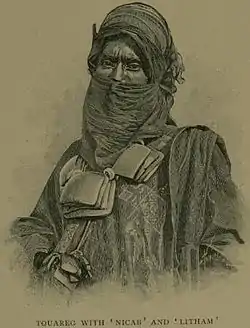Litham
Litham (Arabic: لِثَام, romanized: lithām) is a mouth-veil which the Tuareg and other North African nomads, particularly men, have traditionally used to cover the lower part of their face.[1]
 Tuareg man wearing a litham | |
| Type | mouth-veil |
|---|---|
| Material | cloth |
| Place of origin | North Africa |
| Manufacturer | Tuareg, and Sanhaja people |
Role and significance
The litham has served as protection from the dust and extremes of temperature characterizing the desert environment.[1] In cases of blood feuds, it also served as protection against violence by making the wearer difficult to recognize.[1] Wearing of the litham is not viewed as a religious requirement, although it was apparently believed to provide magical protection against evil forces.[1] It is included among the garments which pilgrims are forbidden to wear by the Islamic doctrine in the ritual state of ihram.[1]
History and practice
Ancient African rock engravings depicting human faces with eyes but no mouth or nose suggest that the origins of litham are not only pre-Islamic but even pre-historic.[1] The litham was commonly worn among the Berber Sanhaja tribes in north-west Africa.[1] Its use by the Almoravids, who originated from a Sanhaja clan, gave it a political significance during their conquests in the 11th and 12th centuries.[1] This practice gave rise to Almoravids being pejoratively nicknamed al-mulaththamun (the muffled ones).[2] The Almohads, who succeeded the Almoravids as the dominant dynasty in the North African region, opposed the practice of wearing the litham, claiming that it is forbidden for men to imitate women's dress, but they never managed to suppress its use.[1]
Among the Tuareg, men wear the litham, also called tagelmust, while women go unveiled.[3] Tuareg boys start wearing the litham at the onset of puberty and the veil is regarded as a mark of manhood.[3] It is considered improper for a man to appear unveiled in front of elders, especially those from his wife's family.[3] The Tuareg litham is made of several pieces of Sudanese cloth which are sewn together to yield a strip about four yards long.[4]
In literature and folklore
A number of legends were invented to explain the custom of male veiling.[1] According to one, the wearers of litham descended from members of the Umayyad family, who escaped to Africa disguised as women after the fall of the Umayyad dynasty, and never took off the veil.[1] When one fell in battle and lost his litham, his friends could not recognize him until it was put back on.[1] The word litham and its derivatives have been widely used in Arabic literature, in particular by the poets, who commonly employed puns between the general meaning of litham as veil and the verbal root lathama, which means "to kiss".[1] In One Thousand and One Nights women use the litham to disguise themselves as men.[1][5] The classical dictionary Lisan al-Arab by Ibn Manzur treats lifam as a separate word, describing it as a mouth veil worn by women.[1]
See also
References
- Björkman, W. (2012). "Lit̲h̲ām". In P. Bearman; Th. Bianquis; C.E. Bosworth; E. van Donzel; W.P. Heinrichs (eds.). Encyclopaedia of Islam (2nd ed.). Brill. doi:10.1163/1573-3912_islam_SIM_4672.
- John L. Esposito, ed. (2009). "Murābiṭūn". The Oxford Encyclopedia of the Islamic World. Oxford: Oxford University Press. ISBN 9780195305135.CS1 maint: ref=harv (link)
- Allen Fromherz (2008). "Twareg". In Peter N. Stearns (ed.). Oxford Encyclopedia of the Modern World. Oxford University Press. ISBN 9780195176322.
- Douglas Porch (2005). The Conquest of the Sahara. Macmillan. p. 78. ISBN 9780374128791.
- The thousand and one nights, or, The Arabian nights' entertainments. 2. J. Murray. 1847. pp. 60, 143.